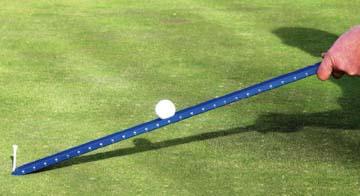Throughout his travels, USGA Green Section agronomist Brian Whitlark says he tells superintendents "you can't manage what you can't measure."
Superintendents often hear members grouse that areas on greens are too fast, or too slow. But the slope in those areas of question often is so great that there isn't enough flat space to get an accurate reading of speed using a traditional Stimpmeter. Although the superintendent manages that area like the rest of the green, the actual reading is merely a guess.
To that end, the USGA recently released an updated version of the Stimpmeter designed to help superintendents take accurate readings in areas they previously couldn't before.
 A traditional Stimpmeter requires a minimum of 10 to 15 feet of flat surface in two directions to get an accurate reading, but the 2X allows superintendents to determine accurate green speeds in half the distance simply by multiplying the reading by 2, according to the USGA. Tested in closed settings and in the field, the 2X results in readings that are extremely accurate, the USGA says.
A traditional Stimpmeter requires a minimum of 10 to 15 feet of flat surface in two directions to get an accurate reading, but the 2X allows superintendents to determine accurate green speeds in half the distance simply by multiplying the reading by 2, according to the USGA. Tested in closed settings and in the field, the 2X results in readings that are extremely accurate, the USGA says.The USGA made the 2X available in January. At first glance superintendents might not notice much of a difference between the new version of the Stimpmeter and their old one. Both are 36 inches long, and both have a notch 30 inches from the end that releases a golf ball when the bar is raised to an angle of 22 degrees.
It's on the flip side where superintendents will notice what's new. The other side also has a notch, but this one is located halfway down the chute. It also releases the golf ball when raised to an angle of 22 degrees, but since the ball gets a shorter head start it does not roll as far. Instead of measuring green speed over 10 to 15 feet, the 2X can do so in as little as 7 or 8 feet.
"If one green is not rolling the same as the others, you'll now have the information to determine if you need an extra mow or roll if it's too slow, or to put down water if it's too fast," Whitlark said. "Before, you wouldn't have the information to make those decisions."
Steve Quintavalla, Ph.D., of the USGA Research and Test Center developed the 2X in cooperation with the Green Section. A prototype was tested in a controlled environment in New Jersey before being tested in the field in 2012.
One such test site was The Olympic Club in San Francisco, where Whitlark used it daily during preparation for last year's U.S. Open. To test the accuracy of the 2X, Whitlark said he used it on Olympic's 10th green, among the flattest on the Lake Course. The 2X readings were virtually identical to those derived by using the 1X or traditional Stimpmeter on long, flat runs.
The new tool, the USGA says, finally gives superintendents the ability to accurately determine green speed in areas they could not do so before.
"With the 1X (traditional Stimpmeter) you have to have a good-size area to roll in both directions," said the Green Section's Bob Brame. "With the 2X the area you need is half. It's going to allow you to check speeds on some greens you couldn't check in the past, and that's a good thing."
As with the traditional Stimpmeter, the 2X was designed not to maximize green speed but to achieve consistent conditions over the entire putting surface, and using it should enable superintendents to achieve consistent conditions to within 8 inches throughout all 18 greens, Whitlark said.
"When a member comes to you and asks why No. 5 is faster, you'll have that number and you can answer that it is faster, or that it's just slope," Whitlark said. "Without that number, you're just guessing just like they are."
Whitlark says that superintendents still should use the longer side when measuring green speed when there is sufficient flat surface available.
"If you can get a speed using the 1X, then you should still use that," Whitlark said. "You always want the ball to roll on as much green as possible."
The 2X Stimpmeter is available through the USGA for $110, or for $75 for those who trade in their traditional Stimpmeter (regardless of its manufacturer).

